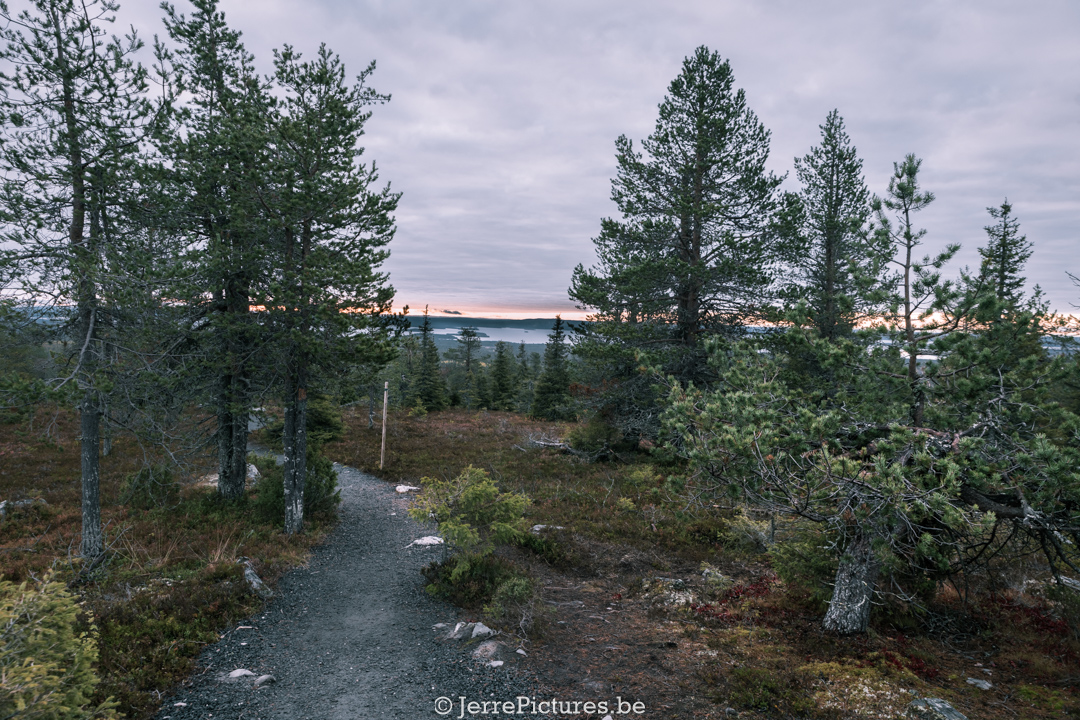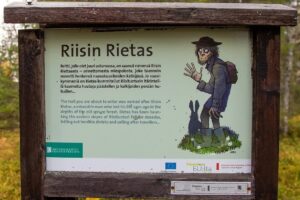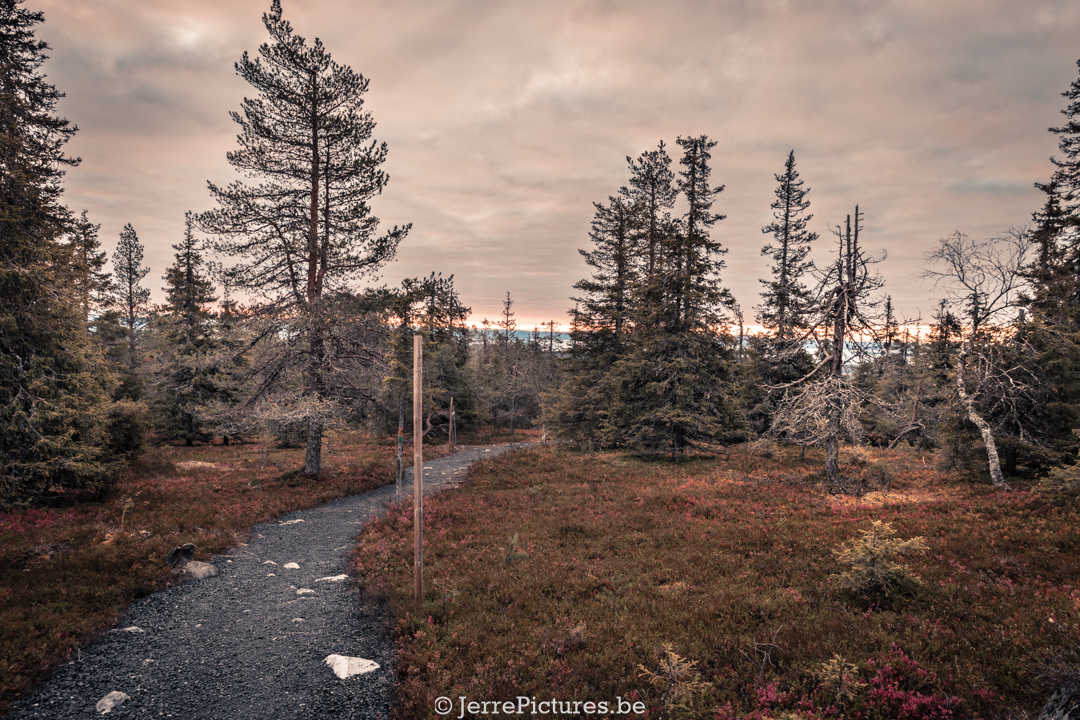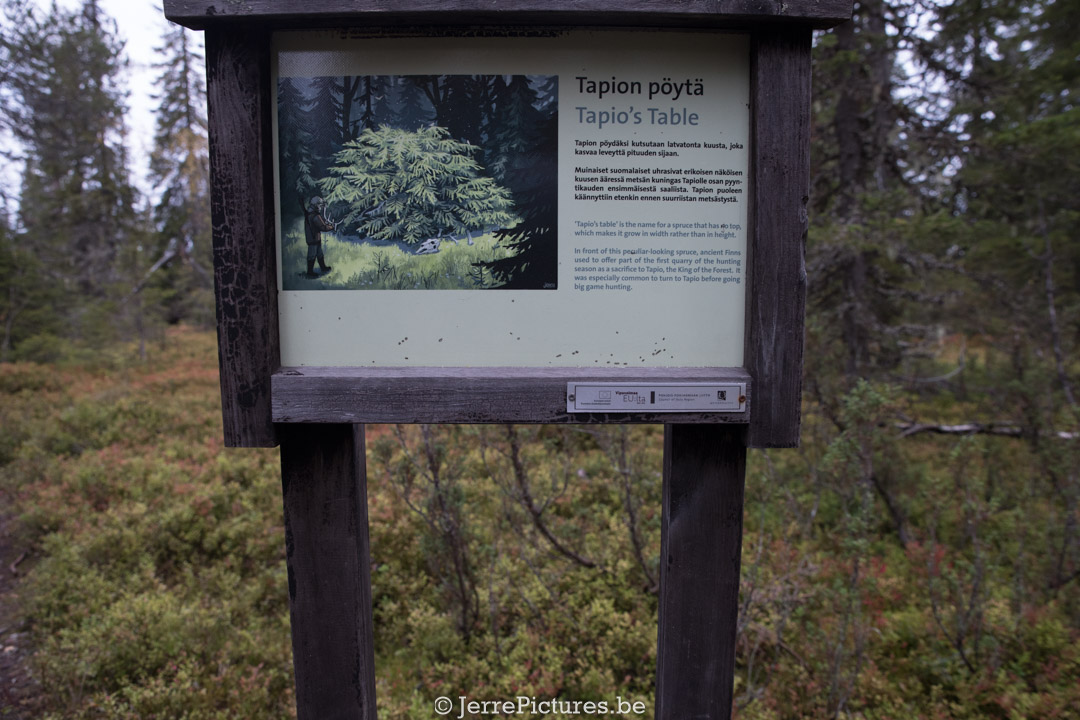
Riisitunturi National Park: A Changing Paradise in Finnish Lapland
An Unexpected Change Upon Arrival
When I returned to Riisitunturi National Park in September 2024, located in southern Finnish Lapland, the transformation of the park was clearly evident. The quiet parking lot from my first visit in 2019, where I was alone with only the sound of a calling owl and the rustling of wildlife, had now been transformed into a spacious lot accommodating over a hundred vehicles. (More about this in the chapter ‘Accessible for Campers and Overlanders’) This time, there were fifteen camper vans and a few cars spending the night. The contrast with the silence of my previous visit couldn’t have been greater.
The Promise of a Magical Walk
 The Riisin rietas trail, named after a tragic legend that still wanders through the woods, promised a renewed acquaintance with the beautiful yet demanding nature of the park. Although I hadn’t been active for some time due to health reasons (a few years), the hike seemed manageable to me, but my girlfriend found the path cold, steep, and wet. Her frustration during the climb stood in stark contrast to my own memories of how easy the trail had seemed to me before and still did. It was somewhat frustrating, but it also made me realize that when I write stories in my blog about an easy path, it might not be entirely true. And how do you measure something like that?
The Riisin rietas trail, named after a tragic legend that still wanders through the woods, promised a renewed acquaintance with the beautiful yet demanding nature of the park. Although I hadn’t been active for some time due to health reasons (a few years), the hike seemed manageable to me, but my girlfriend found the path cold, steep, and wet. Her frustration during the climb stood in stark contrast to my own memories of how easy the trail had seemed to me before and still did. It was somewhat frustrating, but it also made me realize that when I write stories in my blog about an easy path, it might not be entirely true. And how do you measure something like that?

Is Riisitunturi Accessible by Camper or Overlander?
On your way to Riisitunturi National Park, you’ll quickly notice that you’re entering a different Finland. Depending on where you’re coming from, this may be a Finland of treacherously poor gravel roads, riddled with potholes, where it sometimes seems like no one lives at all. Yet, surprisingly, you’ll encounter numerous cabins and even bus stops along these remote paths. If you’re in an expensive camper, you might have hoped for something different, but the Finnish wilderness demands a humble 20 km/h—you’ll either crawl or come to a standstill, Or your drive like a mad man and your furniture will be pasted to the ceiling of your camper for free.
Once you arrive, you’ll likely find a spot to park your vehicle, as there are over 100 spaces available. Large campers can fit in without any issues. However, parking etiquette sometimes leaves much to be desired. While some campers understand the art of discreet parking and stick to the back rows, others cram their shiny contraptions as close as possible to the trailhead. After all, that extra 100 meters to the trailhead before hiking 10 km might just be that bridge too far.
Interestingly, both parking and overnight stays here are free of charge. Our journey took us via ‘The Silent People,’ a short detour that’s definitely worth it if you’re coming from the ferry in Helsinki. After a long day of driving, if you still have the energy to brave the cold, you might even spot the Northern Lights here. But that’s only if sleep hasn’t overtaken you after such a heroic trek through the Finnish landscape.
Download GPS fils and Maps
JerrePictures.be (1 of 1)-2
JerrePictures.be (1 of 1)
JerrePictures.be (19 of 21)
JerrePictures.be (14 of 21)
JerrePictures.be (18 of 21)
JerrePictures.be (16 of 21)
JerrePictures.be (15 of 21)
JerrePictures.be (12 of 21)
JerrePictures.be (6 of 21)
JerrePictures.be (9 of 21)
JerrePictures.be (11 of 21)
JerrePictures.be (3 of 21)
JerrePictures.be (1 of 1)
JerrePictures.be (14 of 18)
JerrePictures.be (3 of 15)
JerrePictures.be (3 of 18)
JerrePictures.be (4 of 15)
JerrePictures.be (7 of 15)
JerrePictures.be (8 of 15)
JerrePictures.be (10 of 15)
JerrePictures.be (11 of 15)
JerrePictures.be (12 of 15)
JerrePictures.be (13 of 15)
A nerdy Deep dive into ‘Riisitunturi Nationaal Park’:
The Hidden Wonders of Riisitunturi National Park
Natural Artwork: Tykky and Snow-Covered Trees
In winter, Riisitunturi National Park undergoes a magical transformation. The trees are cloaked in a thick layer of snow known as ‘Tykky,’ formed by the combination of high humidity and frost. These snow sculptures can become so heavy that the branches bend downwards, creating a surreal landscape that attracts photographers from around the globe.
A Paradise for Hikers and Cross-Country Skiers
Riisitunturi offers a variety of marked trails inviting exploration of its breathtaking nature. Whether you choose a short hike along the 4.3 km Riisin rääpäsy trail or the more challenging 10.7 km Riisin rietas trail, each path provides unique views and rest areas where you can pause by a campfire. For adventurous visitors, there’s a 20 km multifunctional route suitable for both cross-country skiing and snowshoeing.
A Treasure Trove of Biodiversity
The nature in Riisitunturi is rich and diverse. The western slopes of the fell are covered with Europe’s most impressive hanging peat bogs, while the eastern slopes feature vast wetlands that lead to babbling brooks. The variety of flora and fauna is immense, ranging from the skittish Siberian jay to the rare three-toed woodpecker, offering endless opportunities for nature lovers and birdwatchers.

Cultural Heritage and the Enchantment of the Night Sky
The park is also a guardian of rich cultural traditions, such as the ancient hunting pits that are a reminder of Sami culture. On clear nights, Riisitunturi offers a perfect starry sky free from light pollution, where the Northern Lights perform their mystical dance.
The Sustainability of the Landscape: Fire Management
In Riisitunturi, controlled fire management is applied to mimic the natural cycle of wildfires, which is essential for the maintenance of certain habitats and species that depend on post-fire environments.
Discovery of the Unknown
Every visitor to Riisitunturi can discover something unique, whether it’s the deep tranquility of a solitary walk or the joy of cross-country skiing across the snow-covered plains. The park invites everyone to experience the charm of its enchanting landscapes, offering an escape from everyday life.
Be sure to also check their official website by clicking the link here for the latest information and more interesting facts.

www.nationalparks.fi
Deep Roots: The History of Riisitunturi National Park
Riisitunturi National Park is not only a natural wonder but also a place with deep historical resonance. The park is located in an area that has been home to Sami communities for centuries, and later to Finnish settlers.
Ancient Sami Presence
The first inhabitants of the area were the Sami, an indigenous people whose lives were deeply connected to nature. They lived semi-nomadically, relying on hunting, fishing, and foraging for berries and mushrooms. Traces of their presence are still visible in the landscape, such as the ancient hunting pits strategically placed along reindeer migration routes and the quartzite quarry on the western slope of Fell Nuolivaara.
Transition to Farming Life
In the late 17th century, Finnish settlers began to establish themselves in the area. These settlers, largely dependent on livestock farming, also utilized the natural pastures for their animals. They introduced a more sedentary lifestyle, but hunting and fishing remained important parts of their existence. The use of slash-and-burn agricultural techniques and grazing livestock in the wetlands were common practices well into the 20th century. The restored barns and hay sheds in the Riisisuo swamp are tangible reminders of this period.
Naming and Cultural Significance
The name ‘Riisitunturi’ itself is a subject of speculation and study. In old maps, it was written as ‘Riistunturi,’ which in the Sami language may refer to ‘crown snow’ or ‘branches.’ There is also a theory that the name refers to the clubmoss prevalent in the area, a plant that was used in folk medicine to treat rickets (‘riisitauti’ in Finnish).
Protection of the Wilderness Area
With the establishment of Riisitunturi National Park in 1982, a significant step was taken to protect the largest wilderness area in the Koillismaa region. This became necessary in response to the increasing pressures of modern lifestyles that began to threaten natural habitats. The park was established to preserve the unique peat bogs and ancient forest areas, as well as the biodiversity that supports this landscape.
Please kindly attribute any information taken from this website and read this site Terms And Conditions for the exact conditions




